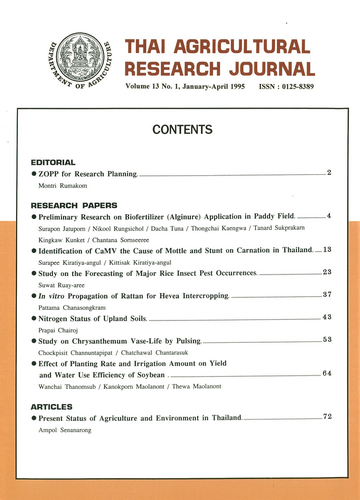Study on the Forecasting of Major Rice Insect Pest Qccurrences
DOI:
https://doi.org/10.14456/thaidoa-agres.1995.3Keywords:
Rice insect pests, ForecastingAbstract
The forecasting of insect pests is an important information in IPM. This study was preliminary study to develop the forecasting of rice insect pests in future. The study was carried out at Phan Rice Experiment Station, Chiang Rai province during 1987 - 1993, both in dry season and wet seson. Two methods of the studies were done, those were statistical method and experimental method. The first method; one light trap was installed in the station and the number of rice insect pests was counted every day. Data of temperature and rainfall were also recorded from climatic station. The relationship between abundant of insects and climatic condition was calculated. The second method; in dry season and wet season crop, RD1 and RD23 rice varieties were transplanted in 20x40 m per plot in seperate. None of insecticide was used. Sampling of the rice stemborers and rice gall midge, Orseolia oryzae, was done by direct counting and sweep net was used weekly for investigating population of leafhoppers and planthoppers.rnThe results showed that the green leafhopper, Nephotettix spp., was the most abundant. More than 50% of rice insect pest caught in light trap was the green leafhopper. The rice stemborer was found abundant during January to March of average temperature 22.9 ?C in dry condition. Leafhoper and planthopper were abundant during September to December of average temperature 24.5 ?C in dry to wet of rain condition. Rice gall midge was abundant during September to October of average temperature 25.5?C in dry to wet of rain condition.rnIn dry season crop, rice stemborer was found to be a key pest. The infestation of rice stemborer in RD1 and RD23 fields was mostly above economic threshold level (ETL) (>10%). High infestation was found in no rainfall condition. In wet season crop, rice gall midge was a key pest. The infestation was above ETL (>5%) every year and high infestation was founds in slight to heavy rain condition. It was found highly significant positive correlation between the number of rice gall midge in light trap and its infestation in rice field. The green leafhoper was also abundant in the field in wet season crop and its numbers in light trap and in rice field was found highly significant positive correlation in the experiment. So, light trap could be utilized in forecasting of rice gall midge infestation and green leafhopper occurrence in rice field.
Downloads
Published
How to Cite
Issue
Section
License

This work is licensed under a Creative Commons Attribution-NonCommercial-NoDerivatives 4.0 International License.
Thai Agricultural Research Journal



